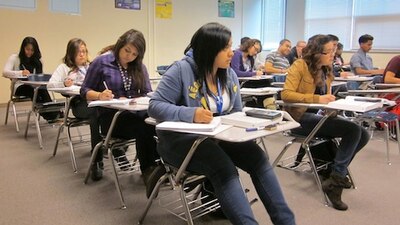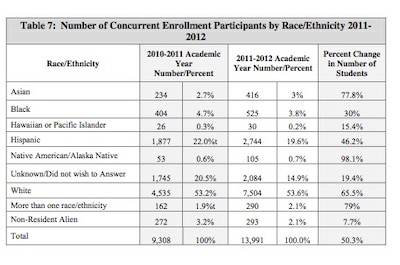AURORA – The number of Colorado students who earned college credit while still in high school jumped 15.5 percent between 2010-2011 and last year, Lt. Gov. Joe Garcia announced Wednesday.

Known as “concurrent enrollment,” the program helps students gain core college credits before they graduate from high school.
The strategy is considered a fundamental piece of the state’s plans to improve college completion, particularly by minority students. Colorado has the second-largest degree attainment gap in the country between white and Hispanic students. Garcia also said future employment needs will require 67 percent of Colorado adults to have some sort of post-secondary credential. Currently 47 percent of adults over age 25 have an associate’s degree or higher.
Last year alone, officials say dual enrollment in college courses saved Colorado families $10 million in what they would have otherwise spent on sending students to college.
“You can’t have a globally competitive workforce unless all students have the opportunity to graduate from high school and move successfully into college,” Garcia said. “More students need to get a post-secondary credential, but that’s becoming increasingly unaffordable. Any program that allows students to be successful and doesn’t cost that student and family a lot of money can really work.”
A college degree is “not something that should be available to only some of our students,” he added.
Dual enrollment stats in Colorado
About 24,000 – or 19 percent – of Colorado’s high school students participate in dual enrollment programs. And of those, 85 percent enrolled in college after high school graduation. Additionally, those students also had higher first-year grade point averages (2.66) compared to students who had not taken college courses in high school (1.89). And, 78 percent of those who took college courses in 2009-2010 and went on to college remained enrolled after their first year, compared to 58 percent of students who did not take college courses in high school.
Garcia and Aurora Public Schools officials released the state’s annual concurrent enrollment report during an event at Hinkley High School, which has the third-highest number of students participating in college classes of any high school in the state.
Aurora is a state leader in using dual enrollment as a way to prepare students – especially minority students from low-income families without past college experience – for college attendance and completion.
Of students who took courses through 18 participating colleges while in high school – either at school or at a college campus – more than 75 percent passed all their courses while 10 percent failed them, the report found. The remainder earned partial credit. Some 64 percent of the state’s high schools, or 304, offer dual enrollment programs.
“We need to be blurring the lines between K-12 and higher education,” Garcia said. “This makes it easier for students to make that transition successfully.”
The two-year institutions with the largest dual enrollment programs were the Community College of Aurora, with 2,722 students, and Arapahoe Community College, with 2,365 students. The four-year institutions with the largest dual enrollment programs last year were the University of Colorado Denver, serving 3,775 students, and Colorado State University Pueblo, serving a little more than 1,000 students.
Enrollment growth reported across racial lines
Especially exciting to educators was the fact that students of color are participating in concurrent programs at a greater rate than ever before.
The number of Native-American students, for instance, nearly doubled from 53 to 105 between 2010-2011 and the following year. The number of Hispanic students rose 46.2 percent from 1,877 to 2,744

“These students were overlooked as potential college students,” Garcia said. “These are the students who are the future of not just our state, but our country.”
However, white students continue to make up the largest segment, 54 percent, of students enrolled in dual enrollment programs, with enrollment of 7,504. That figure is a dramatic 65.5 percent increase over the previous year.
In addition to concurrent enrollment, Aurora also has the state’s highest participation in the two-year-old ASCENT (Accelerating Students through Concurrent ENrollmenT) program, which allows a student who has 12 college credits at the time of high school graduation to stay in the program for a fifth year and have those college costs fully covered by the state. Statewide enrollment in ASCENT grew 50 percent last year to 129 students. (The legislative Joint Budget Committee wants to put a cap on funding for ASCENT).
Alton Scales, president of the Community College of Aurora, called education “truly transformative.”

“We are creating an army of educated people – individuals who will stand in lockstep… not only to transform communities and families, but to redefine who we are nationally as a people.”
Laura Serrano, 19, who is enrolled in the ASCENT program, said it would have taken her years to complete a college degree since her family does not quality for in-state tuition or financial assistance. Now, she is on track to become the first in her family to earn a college degree. She graduated from Hinkley last year in the top 10 percent of her class. This spring she will earn an associate’s of arts degree from the Community College of Aurora. She plans to study communications in the fall at Fort Hays State University in Kansas.
“ASCENT not only provided me with school and classes, I never had to worry about paying for books,” Serrano said. “We’ve also had mentors guide us all through the way.”
